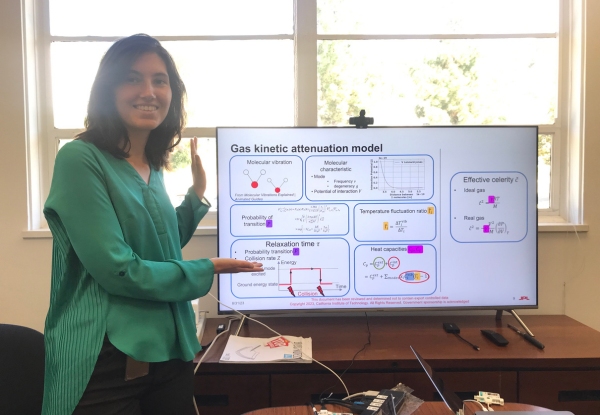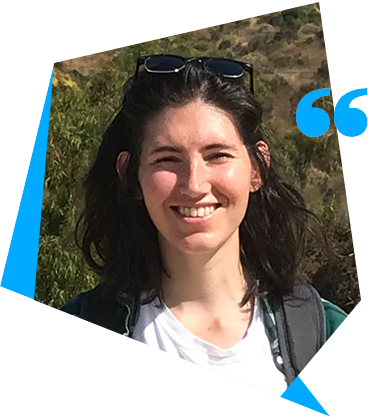< back to articles
3 months at the JPL for Solène
Published on
Solène Gerier carried out a research internship during her second year of doctoral studies in Universe Sciences at ISAE-SUPAERO: she spent 3 months at NASA’s Jet Propulsion Laboratory (JPL) in California. The Foundation awarded him a scholarship in early 2023 to facilitate his departure for the United States. This unique PhD experience enabled her to discover a new angle on her field of research, and to gain international research experience. She tells us all about her stay!

What does your thesis involve?
My thesis work focused on the development of numerical methods for characterizing the Earth’s atmosphere based on experimental measurements using infrasound waves. At JPL, my internship focused more specifically on studying the attenuation properties of Venus’ atmosphere. This research theme enabled me to take up another line of research related to my work, while strengthening my skills in numerical modelling and simulation. The second motivating factor was the discovery of a new culture and working environment. Indeed, the American way of working is very different from that of the French, and I wanted to discover a new way of working in order to perfect my PhD experience. What’s more, international experience is often a prerequisite for a research career in France, I wanted to take advantage of this internship to ask myself about the possible career options open to me during my final year of doctoral studies. (industry or research, field of study, type of establishment, country, etc.).
Tell us about the course itself
Solène Gerier

my internship took place in the Ionospheric and Atmospheric Remote Sensing Group (IARS), whose aim is to deepen our understanding of the atmosphere and ionosphere of planets. In particular, my internship was focused on one of the team’s Venus exploration projects.
The aim of this project is to develop measurement tools to study the seismicity of Venus. These measuring instruments are stratospheric balloons (deployable at an altitude of around 60 km) containing several sensors (pressure, temperature, etc.). In particular, pressure sensors can be used to measure the intensity of acoustic waves – waves caused by vibrations of the planet’s surface following an earthquake. However, sensors present certain measurement drifts and uncertainties, and a number of studies are underway to assess these: deployment of sensors in the earth’s atmosphere, characterization of sensor noise levels, etc.
For my part, I worked on an extrinsic characteristic of the sensor: the attenuation that a wave undergoes. This ensures that the intensity of the acoustic wave is greater than the sensor noise.
Models can be used to characterize attenuation. At present, existing attenuation models are ill-suited to the specific case of Venus’ atmosphere. In fact, the models were developed for the atmosphere of Earth or Mars, which are less dense and have lower temperatures than Venus. The aim of my internship was therefore to improve existing wave attenuation models for Venus.
My study focused on the attenuation of waves within the atmosphere, linked to a specific phenomenon known as “vibrational relaxation”. This phenomenon is linked to the vibration of molecules and the exchange of energy when two molecules collide. This subject allowed me to tackle a number of notions in thermodynamics, a field of physics that was of particular interest to me as I only had an introduction to this subject in my first year of engineering school. This work made me aware of the interdependence of physical domains and the different points of view that can be adopted to solve a problem.
What have you gained from this research internship?
I had the opportunity to improve my “soft skills” during this internship: working in a completely English-speaking environment enabled me to raise my level of English and especially my oral communication skills. I also enjoyed getting out of my “comfort zone” and opening up to a new working environment and culture. In particular, I was able to make many new acquaintances and expand my professional network.
An important point to mention is that I was confronted with technical difficulties during my internship: the first step was to reproduce a current model of wave propagation within Venus. However, this step proved more complicated, as the existing model documentation was not complete, and many of the data and calculation details were not spelled out. Despite the help of one of the authors of the scientific article I relied on, we were initially unable to reproduce the model’s results. I found this challenge particularly stimulating and instructive. In the absence of experimental data and access to the original code, new methods had to be developed to understand the missing steps in reproducing the original model.
Finally, although my internship is officially over, I’m continuing to follow the progress of the work I’ll have the opportunity to present at the American Geophysical Union (AGU) conference in the USA in December 2023.
This internship also gave me the opportunity to get to grips with the research work of my internship supervisor, Mr… Siddharth Krishnamoorthy. In particular, I took part in stratospheric balloon tests, the aim of which was to verify the smooth launch and landing of a balloon. It gave me my first hands-on experience and made me aware of the operational reality that is often forgotten when developing numerical models.
What do you remember about your time at the JPL?
In addition to the research work specific to the internship, I was able to strengthen my scientific culture by taking part in numerous weekly seminars offered by JPL and Caltech University in general. The seminars are extremely diversified, with accessible content, and are organized during lunch breaks to facilitate participation. This last aspect brings me to the immense nature of JPL. This is made possible by the size of the laboratory, with over 6,000 employees working in a wide variety of engineering and research fields. Working in such an environment is therefore particularly rewarding and stimulating.
I’d also like to point out that this internship was my first experience in a large institution, similar to a company. I was able to assess the many advantages, but also the disadvantages. One of the advantages is being part of a large community. Although JPL is structured “in silos” (division into sections, divisions and groups), exchanges within the laboratory are simplified by the use of “Slack”. This platform allows you to discuss news, seminars, ask for advice or exchange ideas on activities. For example, I discovered a hiking and dodgeball group at the institute, and was able to try my hand at these sports on several occasions. What’s more, JPL goes to great lengths to ensure that its employees (including trainees) enjoy a friendly working environment. In addition to seminars, JPL organizes a number of social events (e.g. ice cream socials) and has a dedicated service for trainees to organize activities and get to know each other (e.g. launch meetings, trainee-specific seminars and tours of facilities such as the Space Flight Operations Center).
I also discovered the relationship that Americans have with work. As I have a master’s degree in management, I found it very interesting to observe the management of the laboratory. In particular, I was able to attend the annual “town hall”, an event where the JPL director presents the year’s results and the objectives for the coming years, while reminding us of JPL’s values and answering employees’ questions. This presentation provides an overview of the management method used at JPL.
Finally, this experience gave me some answers about my orientation, and more specifically about my attraction to the field of research, where we are constantly learning, innovating and finding answers through collaboration. On the other hand, although I enjoyed my time in the U.S., I’d prefer to settle in France, where I feel more in tune with the values held by Americans in general.
And on a personal level, what do you take away from this experience?
In addition to the internship, this experience was also a change in my lifestyle. First of all, I was for the first time in a shared apartment with an American working in the same laboratory as my internship. The flat-sharing went extremely well and I was lucky enough to be accompanied by my roommate to help me acclimatize to this new way of life. However, I regret not having stayed in the student residences, which are an excellent way of forging links with the other trainees, the vast majority of whom have completely different backgrounds to my own. I also took part in a number of activities with the other trainees, such as cultural and sporting outings and hikes.
This experience allowed me to get to know myself better. Indeed, being “alone” in a country with a culture different from our own helps us to refocus on ourselves. In particular, I had to be autonomous and independent in order to organize my weekends to discover the city and its surroundings. In particular, Los Angeles is a very cosmopolitan city, with a strong Latin culture and many immigrants from Latin America, especially Mexico. As a result, Spanish is widely spoken in the city, as is Latin American architecture and food. For example, for the first time I ate “real” Mexican tacos, which have nothing in common with their French counterpart. Other specific neighborhoods include the Chinese, Japanese and Korean quarters. This mix also brings out the different personalities within the city, with their own particular styles of dress and lifestyle. An important point to mention is the tolerance shown by the “Angelinos”, which allows for a great deal of creativity. Los Angeles is also a culturally and artistically rich city. I was able to visit many museums and discover the city, its surroundings and its history. Another cultural highlight is the national holiday on July 4, with all its festive events (gatherings, fireworks, etc.).
My day-to-day experience has also enabled me to compare ecological practices in the United States with those in France. The ecological footprint is very large in the United States, with cars being the primary means of travel, air-conditioning being over-used and waste being rampant. Another shocking point is the lack of reusable cutlery in the JPL cafeteria, where plates and glasses are made of plastic … I found these uses alarming. What’s more, even though I went to a so-called “developed” country, the experience made me take a step back in terms of our role in society, and echoed my training as a “humanist” engineer. In Los Angeles, I saw a large number of homeless people, public complaints on public transport and many people who didn’t dare go to the hospital for lack of money. These precarious situations are juxtaposed by abundant wealth, with very elegant neighborhoods, often accompanied by cars that are too big for most French people. Many affluent Americans seem to be burying their heads in the sand, locking themselves away in their daily routines.
To conclude?
The trip turned out to be an unprecedented human experience, rich in scientific, technical and cultural terms. Having had the opportunity to travel to other countries for shorter periods of time (1 month in Ireland and India, for example), I feel that a minimum of two months is necessary to melt into a new culture, and I remain very grateful to have had the opportunity to have such an experience during my second year of doctoral studies.
I would like to warmly thank the Foundation and the donors for their confidence in my project. It was an enriching, transforming experience that I’ll never forget. I think it’s extraordinary that the Foundation and its donors are able to give such an experience to so many projects, and I hope that these actions will continue for a long time to come for future students.